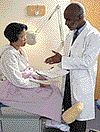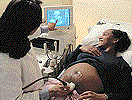Facts about fibroids
In 1984, Lesli Hicks complained to her gynecologist that her lower back hurt. She was told that she'd probably lifted something incorrectly. She sought a second opinion and an ultrasound examination.
Fibroids don't necessarily signal an end to childbearing. In fact, several treatments for these noncancerous tumors destroy the fibroids and save the uterus.

In 1984, Lesli Hicks complained to her gynecologist that her lower back hurt. She was told that she'd probably lifted something incorrectly. She sought a second opinion and an ultrasound examination. At this time, cysts, endometrial tissue, and fibroids were discovered around Lesli's ovaries, and were removed by laparoscopy. Several weeks ago Lesli began experiencing problems again. This time the culprit is a tennis-ball sized fibroid above her uterus.
Is a fibroid actually considered a tumor?
Fibroids are tumors comprising smooth muscle cells wrapped in a fibrous covering. They are found in the wall of the uterus and sometimes on the cervix. If you held one in your hand, it would almost look like a little pink rubber ball, says Dr. Sheri Maxwell, Fellow of the American College of Obstetrics and Gynecology. Also called myomas, leimyomas, or fibromyomas, these overgrowths of uterine tissue are rarely cancerous. According to Maxwell, less than .8% are malignant.
At age 34, Lesli is in the prime age bracket for developing fibroids. They occur in 20%-30% of women over age 30, and in the U.S., are the most frequent basis for hysterectomy. A woman is more likely to get fibroids if she has never been pregnant or has a close relative with fibroids. For unknown reasons, fibroids strike African American women twice to three times as often as other women.
Symptoms
Symptoms of fibroids range from none at all to heavy and prolonged menstrual cycles, backache, urinary frequency and/or incontinence, a sensation of pelvic heaviness, or pain with sexual intercourse. In some cases, fibroids are responsible for recurrent miscarriages. In rare cases, they've also been linked to infertility.

Fibroids can form inside or outside the uterus, or within the uterine wall. They can grow larger than a grapefruit or remain as tiny as a pea. "We grade fibroids in the same manner as you would grade gestational age of a fetus. Any gynecologist in the world understands when I say that "my patient's fibroids are about 16 weeks in size", says Maxwell. "I've had women walk into my office who look seven months pregnant [from a fibroid]" she adds.
Estrogen affects the growth of fibroids. Many fibroids are discovered during pregnancy, because they tend to become larger as pregnancy causes an increase in estrogen. Conversely, as estrogen production tapers off during menopause, fibroids may shrink or even disappear.
Diagnosis
Fibroids are often discovered during a gynecologic check-up. An ultrasound examination is used to confirm the diagnosis. If the fibroid is large enough, you may be able to feel it yourself by placing your hand on top of it.
If you are found to have fibroids, you will probably be monitored for a few months to determine their growth rate. If they're not especially large or problematic, and aren't suspected as a cause of infertility, continued monitoring ("watch and wait") may be the only treatment you need.

Treatment
The position of the American College of Obstetrics and Gynecology is that, barring any unusual complications, treatment is usually not indicated until the fibroids are greater than 12 weeks in size (weighing anywhere from 280-320 grams). "Instead, we try to follow these patients conservatively," Maxwell reports.
When treatment is required, there are a variety of options. Medication is often a first option, in an effort to control bleeding and/or shrink the fibroid. Commonly used drugs include antiprostaglandins such as Motrin. "We have women take this medication 24 - 48 hours before the onset of their menstrual cycle and take it throughout the cycle to help decrease uterine blood flow. Of course it may help decrease cramping too," says Maxwell.
Another type of drug is often used to shrink fibroids. Gonadotropin releasing hormone agonist (GnRH) drugs such as leuprolide (Lupron) or nafarelin (Synarel) block the production of estrogen by the ovaries, depriving fibroids of an important growth source. Because these drugs often cause the side effects associated with menopause- -hot flashes, vaginal dryness, decreased libido, etc., they are not usually taken for more than 6 months. And, the fibroids usually recur within several months after the GnRH drugs are stopped if the patient doesn't undergo surgery. These drugs are sometimes used to shrink fibroids prior to surgery, so that the surgical procedure is less arduous.
If drug therapies prove unsuccessful, surgery is an alternative. Individual fibroids can be removed using a procedure called myomectomy. Myomectomy removes the fibroids, but retains the uterus. There are three approaches to this particular surgery.
Laparotomy--The abdomen is surgically opened and the fibroids are removed under direct vision. Depending on the size and location of the fibroid, this procedure can require several days in the hospital and a 6- to 8-week recuperation.
Laparoscopy--a laparascope is inserted through a small abdominal incision. A laser is used to remove the fibroids.
Hysteroscopy--the fibroids are cut out and the uterine lining is destroyed via a laser (laser ablation). Without a uterine lining, women cannot bear children. Recuperation from both laparoscopic and hysteroscopic procedures takes between a week and 10 days.
Myomectomy is intended to leave the reproductive tract intact, but is not without risks: excessive bleeding during surgery can require an emergency hysterectomy (removal of the uterus). In 15% of women who have had a myomectomy, fibroids recur.
The only definitive cure for fibroids is hysterectomy - removal of the uterus. Each year, approximately 180,000 women undergo fibroid- related hysterectomies in the United States. This is a third of the 600,000 hysterectomies performed in the United States every year. Hysterectomy is recommended when fibroids are very large or if bleeding becomes life threatening.
There is good news on the horizon. Several newer, less invasive procedures are being investigated. Among them: myolysis, in which a needle is inserted into the center of the fibroid and electrocuted; and cryotherapy, in which a probe is inserted into the fibroid. The fibroid is frozen from the center out. In both cases, the fibroid is destroyed and absorbed by the body and can be performed without a large abdominal incision.
"If you were 45 and you needed surgery, I would counsel you for hysterectomy--why come back? But if you were 23 and we had to do something, I would counsel you to have a myomectomy," says Maxwell. Remember, though, that ultimately the decision is yours. It behooves you to be well-read, well-informed, and aware of all your alternatives.
Resources
American College of Obstetricians and Gynecologists Resource Center
409 12th Street
P.O. Box 96920
Washington, DC 20090-6920.
Offers pamphlet "Uterine Fibroids" (stamped, self-addressed, business-size envelope)
The American Society of Reproductive Medicine
1209 Montgomery Highway
Birmingham, AL 35216-2809
Offers booklet "Uterine Fibroids: A Guide for Patients," ($1)
Further Reading
Fibroids: symptoms and treatment. National Women's Health Report 1996;1815
Christiansen JK. The facts about fibroids: presentation and latest management options. Postgraduate Medicine 1993;94:129-37
Dranov P. When the diagnosis is fibroids. American Health, 1993;12:68-70
Hutchins FL. Uterine fibroids: diagnosis and indications for treatment. Obstet Gynecol Clinic NA; Dec 1995
Stringer N. Uterine fibroids: What every woman needs to know. Physicians and Scientists Publishing Company; 1996
References:
This article was provided courtesy of
HealthGate
, all rights reserved.
S1E4: Dr. Kristina Adams-Waldorf: Pandemics, pathogens and perseverance
July 16th 2020This episode of Pap Talk by Contemporary OB/GYN features an interview with Dr. Kristina Adams-Waldorf, Professor in the Department of Obstetrics and Gynecology and Adjunct Professor in Global Health at the University of Washington (UW) School of Medicine in Seattle.
Listen
